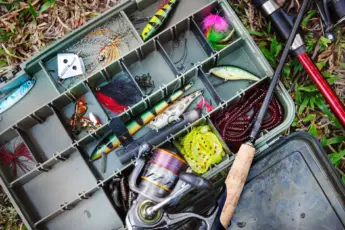One of the most fun ways to catch bluegill is on a lightweight fly rod. Fortunately, the species of fish are abundant in most lakes and ponds across Georgia, South Carolina, and North Carolina. As a result of the abundance, anglers have the opportunity for nonstop action for a rod bending tussle. Here are some of the most common questions of anglers attempting bluegill fishing on a fly rod.
How Do You Catch Bluegill On A Fly Rod
When it comes to how to fly fish for bluegill. The process of catching bluegill on a fly rod is simple. First off, practice casting with a bluegill fly rod to become comfortable before heading off to the lake or pond. The backyard is undoubtedly the best place to learn.
Second, ensure to use a light tippet and three-weight fly rod combination. The panfish are small in size and therefore do not require heavy gear.
Flies that are small in size are best to present to bluegill. The mouths of the fish are capable of biting size eight flies.
Remember, the fish congregate in schools. When you find one, more will be present. Look for weedy shorelines and other structures but avoid casting in areas where the line will become hung on trees or riprap.
It should be noted to cast and keep the fly moving after it settles from a cast. The motion of the lure will draw strikes. Should the fish not bite on the initial presentation, recast to a new location and repeat the process.
What Are The Best Flies For Bluegill
The best flies to draw strikes include nymphs, poppers, minnow imitations, and more. Equally as important is that the flies can be both wet or dry.
Regarding what size flies for bluegill, we recommend flies ranging between #12 and a number #18. These size flies for bluegill will increase the number of hookups versus misses.
Remember, without a doubt; it is essential to place the fly within the vicinity of fish. Keep an eye out for boils near the surface or by identifying bluegill in the water. Avoid spooking the fish by casting directly on top of them as they swim.
What Is The Best Time To Fish For Bluegill
Water temperatures impact where the fish are located. During the cold winter months, bluegill head deep for warm water. In contrast, in the heat of the summer, look for the fish species near the surface of the water. Knowing what depth the fish hold when better improve catch rates when bluegill fly fishing.
Bluegill is most active when the pond or lake temperatures range between 70 and 80 degrees. Of course, this does not mean you cannot catch fish year-round. Adjustments are made to catch fish during all seasons.
What Are Bluegills Favorite Food
Bluegill consumes a wide variety of living organisms. The diet consists of insects and aquatic life. In other words the fish eats minnows, crawfish, insects, eggs, and more. It is essential to match what the fish is eating to the type of flies you’re selecting to cast. Therefore, the best bluegill flies match the hatch, so to speak.
What Is A Good Size Bluegill To Keep
First, when keeping bluegill, follow the laws by verifying size requirements and limits. Generally speaking, a bluegill over seven and a half inches in size is large enough to harvest.
Unfortunately, each fish yields a small percentage of meat; therefore throw enough in the icebox for a complete meal.
Are Bluegill Healthy To Eat
Panfish are excellent to eat, especially when fried. However, consuming fish from ponds poses a risk to human health.
Many ponds are treated with chemicals to control water quality and are also subject to runoff of fertilizers and pesticides from surrounding lands. Use caution when consuming pond harvested bluegill.
Fly fishing bluegill in Large lakes is the best source of consumable fish. Review the state’s health advisories for warmings specific to the lake in which you are fishing.
The fillets are an excellent source of nutrition because they are low in calories and rich in vitamins and nutrients, including proteins.
Head Out Fly Fishing For Bluegill
Are you ready to head out fly fishing for bluegills? Bluegill fishing is fun for the entire family whether you are a novice or an experienced angler. Fortunately, this fish species is easy to find because most are stocked and tend to form in schools. Consider bluegill fishing a stepping stone to chasing bigger fish with a fly combo like salmon and trout. However, the nonstop action will keep you coming back for more.








Article Comments